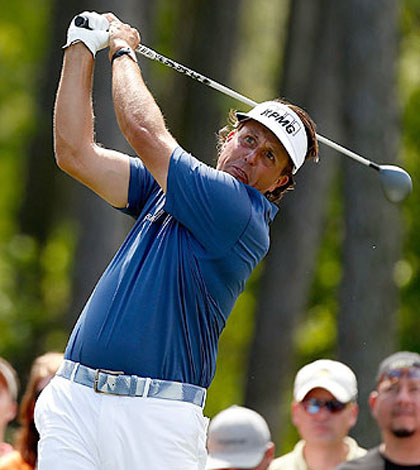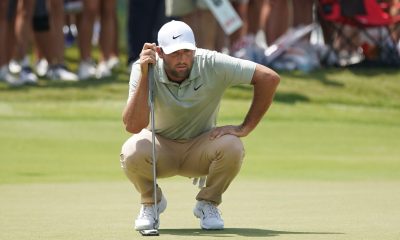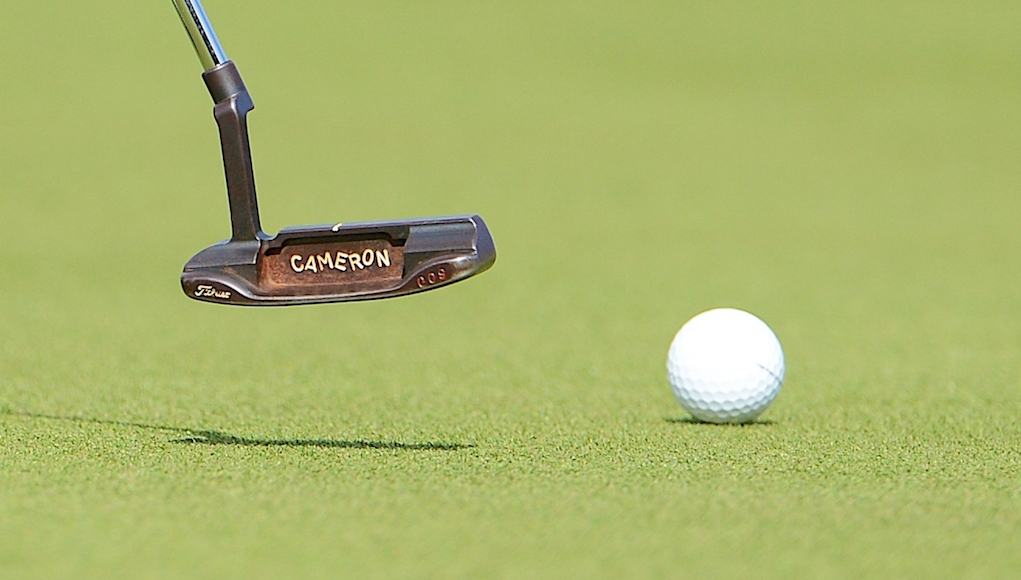Opinion & Analysis
Do Fairways Hit Equal Low Scores?

If you’ve played this game long enough, you know how important it is to hit the fairway. It allows any of us to control the ball’s spin and flight far easier than out of the rough or in a bunker.
With that being the case, one would think that the men winning on the PGA Tour week-in and week-out would be the leaders of fairways hit. It is easy to come to this conclusion but a look at the stats is surprising. Tiger Woods, the greatest golfer of our time, is no straight hitter off the tee and neither is Phil Mickelson, the next winningest player on Tour. So how is it that they win so frequently? Because driving accuracy is not as important as you might think.
Driving the golf ball straight is important, but there are far more important stats like Strokes Gained-Putting and scoring. Driving the ball straight is far less important than putting and getting up and down from 100 yards and in.
Of course, golfers can’t hit it all over the planet; they have to keep it in bounds and out of hazards. So if you’re hitting 70-yard slices and hooks that should be a addressed, but if your stats show you miss fairways but keep it within the tree line and you’re still not scoring, hitting it straighter might not be the pace to focus.
The top-10 players leading in driving accuracy on the PGA Tour are probably not who you think they are. There is definitely something to the adage “drive for show, putt for dough.” Below are two graphs, the first is showing the top-five leaders in driving accuracy, the second is showing the top FedEx Cup points leaders.
Jeff Maggert is fifth in driving accuracy on Tour at 71.46 percent. He also has a very respectable GIR percentage (Greens in Regulation) at 68.20 percent, which ranks him 3oth on Tour. With numbers like that, it would be easy to conclude he would be having a standout year and be ranked high in the FedExCup Standings.But he’s not even close. Maggert is ranked 156th in the FedExCup standings.
Once again, it is all what you do 100 yards and in on a hole. When looking at the first graph, only one man on it is having a stellar year, Graeme McDowell. Why is that? Well, it is easy to see when you move across the graph and look at his scrambling stat. He is a grinder with a scrambling stat of 74.49 percent, which means he makes par 74.49 percent of the time when he misses a green. Jeff Maggert on the other hand only makes par 59.38 percent of the time under those same circumstances.
And the five men leading in driving accuracy are not leading in the strokes gained putting category. All of them, with the exception of McDowell and Kohles, are giving shots back to the field putting.
The first shocking thing noticeable is that Woods and Mickelson are no better than 56 percent in driving accuracy. Tiger, on the other hand, is lapping the field in the strokes gained putting, not so much for Mickelson, but he is very respectable at .345 in that category. Seve Ballesteros was never ever a great driver of the ball but that man could get up and down from the moon.
Snedeker is the most consistent member in this group, because he does everything well. He is not leading in any of the categories, but he is near the top in most. He is a straight hitter with both his woods and irons and he can scramble. It is not hard to see why he is having a standout year this year. Kevin Streelman, who won his first tournament this year at the Tampa Bay Championship, is havign a Snedeker-type season — he’s doing everything well, too.
So what is separating Tiger Woods, who has won three times in 2013, from everyone else? Putting, putting, putting. I’ll take some literary freedom here and draw what I think is the most important thing about Tiger: He is never out of a hole. He may hit it into a bunker or the trees, but he fights it out knowing there is a great chance if he can get on the green with a stroke to spare he will make that putt.
These stats show that we as amateur golfers probably spend too much time working on the long game. A golfer’s time would be far better spent practicing the game from 100 yards and in. With half of the stats on a par 4 allotted to putting, that should tell us something. Also, if a golfer can get his wedge play to be accurate from inside 100, it will wear out the people you play — just ask Jeff Maggert.
With all of this in mind, we should head out to the putting and pitching green and commit to getting good in these areas. I realize spending 30 minutes or more putting doesn’t have the appeal of bombing out long, straight drives on the range. But keep in mind how much lower your scores will get if you only need two shots from inside 100 yards. That should be motivation enough!
Opinion & Analysis
The 2 primary challenges golf equipment companies face

As the editor-in-chief of this website and an observer of the GolfWRX forums and other online golf equipment discourse for over a decade, I’m pretty well attuned to the grunts and grumbles of a significant portion of the golf equipment purchasing spectrum. And before you accuse me of lording above all in some digital ivory tower, I’d like to offer that I worked at golf courses (public and private) for years prior to picking up my pen, so I’m well-versed in the non-degenerate golf equipment consumers out there. I touched (green)grass (retail)!
Complaints about the ills of and related to the OEMs usually follow some version of: Product cycles are too short for real innovation, tour equipment isn’t the same as retail (which is largely not true, by the way), too much is invested in marketing and not enough in R&D, top staffer X hasn’t even put the new driver in play, so it’s obviously not superior to the previous generation, prices are too high, and on and on.
Without digging into the merits of any of these claims, which I believe are mostly red herrings, I’d like to bring into view of our rangefinder what I believe to be the two primary difficulties golf equipment companies face.
One: As Terry Koehler, back when he was the CEO of Ben Hogan, told me at the time of the Ft Worth irons launch, if you can’t regularly hit the golf ball in a coin-sized area in the middle of the face, there’s not a ton that iron technology can do for you. Now, this is less true now with respect to irons than when he said it, and is less and less true by degrees as the clubs get larger (utilities, fairways, hybrids, drivers), but there remains a great deal of golf equipment truth in that statement. Think about it — which is to say, in TL;DR fashion, get lessons from a qualified instructor who will teach you about the fundamentals of repeatable impact and how the golf swing works, not just offer band-aid fixes. If you can’t repeatably deliver the golf club to the golf ball in something resembling the manner it was designed for, how can you expect to be getting the most out of the club — put another way, the maximum value from your investment?
Similarly, game improvement equipment can only improve your game if you game it. In other words, get fit for the clubs you ought to be playing rather than filling the bag with the ones you wish you could hit or used to be able to hit. Of course, don’t do this if you don’t care about performance and just want to hit a forged blade while playing off an 18 handicap. That’s absolutely fine. There were plenty of members in clubs back in the day playing Hogan Apex or Mizuno MP-32 irons who had no business doing so from a ballstriking standpoint, but they enjoyed their look, feel, and complementary qualities to their Gatsby hats and cashmere sweaters. Do what brings you a measure of joy in this maddening game.
Now, the second issue. This is not a plea for non-conforming equipment; rather, it is a statement of fact. USGA/R&A limits on every facet of golf equipment are detrimental to golf equipment manufacturers. Sure, you know this, but do you think about it as it applies to almost every element of equipment? A 500cc driver would be inherently more forgiving than a 460cc, as one with a COR measurement in excess of 0.83. 50-inch shafts. Box grooves. And on and on.
Would fewer regulations be objectively bad for the game? Would this erode its soul? Fortunately, that’s beside the point of this exercise, which is merely to point out the facts. The fact, in this case, is that equipment restrictions and regulations are the slaughterbench of an abundance of innovation in the golf equipment space. Is this for the best? Well, now I’ve asked the question twice and might as well give a partial response, I guess my answer to that would be, “It depends on what type of golf you’re playing and who you’re playing it with.”
For my part, I don’t mind embarrassing myself with vintage blades and persimmons chasing after the quasi-spiritual elevation of a well-struck shot, but that’s just me. Plenty of folks don’t give a damn if their grooves are conforming. Plenty of folks think the folks in Liberty Corner ought to add a prison to the museum for such offences. And those are just a few of the considerations for the amateur game — which doesn’t get inside the gallery ropes of the pro game…
Different strokes in the game of golf, in my humble opinion.
Anyway, I believe equipment company engineers are genuinely trying to build better equipment year over year. The marketing departments are trying to find ways to make this equipment appeal to the broadest segment of the golf market possible. All of this against (1) the backdrop of — at least for now — firm product cycles. And golfers who, with their ~15 average handicap (men), for the most part, are not striping the golf ball like Tiger in his prime and seem to have less and less time year over year to practice and improve. (2) Regulations that massively restrict what they’re able to do…
That’s the landscape as I see it and the real headwinds for golf equipment companies. No doubt, there’s more I haven’t considered, but I think the previous is a better — and better faith — point of departure when formulating any serious commentary on the golf equipment world than some of the more cynical and conspiratorial takes I hear.
Agree? Disagree? Think I’m worthy of an Adam Hadwin-esque security guard tackle? Let me know in the comments.
@golfoncbs The infamous Adam Hadwin tackle ? #golf #fyp #canada #pgatour #adamhadwin ? Ghibli-style nostalgic waltz – MaSssuguMusic
Podcasts
Fore Love of Golf: Introducing a new club concept

Episode #16 brings us Cliff McKinney. Cliff is the founder of Old Charlie Golf Club, a new club, and concept, to be built in the Florida panhandle. The model is quite interesting and aims to make great, private golf more affordable. We hope you enjoy the show!
Opinion & Analysis
On Scottie Scheffler wondering ‘What’s the point of winning?’

Last week, I came across a reel from BBC Sport on Instagram featuring Scottie Scheffler speaking to the media ahead of The Open at Royal Portrush. In it, he shared that he often wonders what the point is of wanting to win tournaments so badly — especially when he knows, deep down, that it doesn’t lead to a truly fulfilling life.
View this post on Instagram
“Is it great to be able to win tournaments and to accomplish the things I have in the game of golf? Yeah, it brings tears to my eyes just to think about it because I’ve literally worked my entire life to be good at this sport,” Scheffler said. “To have that kind of sense of accomplishment, I think, is a pretty cool feeling. To get to live out your dreams is very special, but at the end of the day, I’m not out here to inspire the next generation of golfers. I’m not out here to inspire someone to be the best player in the world, because what’s the point?”
Ironically — or perhaps perfectly — he went on to win the claret jug.
That question — what’s the point of winning? — cuts straight to the heart of the human journey.
As someone who’s spent over two decades in the trenches of professional golf, and in deep study of the mental, emotional, and spiritual dimensions of the game, I see Scottie’s inner conflict as a sign of soul evolution in motion.
I came to golf late. I wasn’t a junior standout or college All-American. At 27, I left a steady corporate job to see if I could be on the PGA Tour starting as a 14-handicap, average-length hitter. Over the years, my journey has been defined less by trophies and more by the relentless effort to navigate the deeply inequitable and gated system of professional golf — an effort that ultimately turned inward and helped me evolve as both a golfer and a person.
One perspective that helped me make sense of this inner dissonance around competition and our culture’s tendency to overvalue winning is the idea of soul evolution.
The University of Virginia’s Division of Perceptual Studies has done extensive research on reincarnation, and Netflix’s Surviving Death (Episode 6) explores the topic, too. Whether you take it literally or metaphorically, the idea that we’re on a long arc of growth — from beginner to sage elder — offers a profound perspective.
If you accept the premise literally, then terms like “young soul” and “old soul” start to hold meaning. However, even if we set the word “soul” aside, it’s easy to see that different levels of life experience produce different worldviews.
Newer souls — or people in earlier stages of their development — may be curious and kind but still lack discernment or depth. There is a naivety, and they don’t yet question as deeply, tending to see things in black and white, partly because certainty feels safer than confronting the unknown.
As we gain more experience, we begin to experiment. We test limits. We chase extreme external goals — sometimes at the expense of health, relationships, or inner peace — still operating from hunger, ambition, and the fragility of the ego.
It’s a necessary stage, but often a turbulent and unfulfilling one.
David Duval fell off the map after reaching World No. 1. Bubba Watson had his own “Is this it?” moment with his caddie, Ted Scott, after winning the Masters.
In Aaron Rodgers: Enigma, reflecting on his 2011 Super Bowl win, Rodgers said:
“Now I’ve accomplished the only thing that I really, really wanted to do in my life. Now what? I was like, ‘Did I aim at the wrong thing? Did I spend too much time thinking about stuff that ultimately doesn’t give you true happiness?’”
Jim Carrey once said, “I think everybody should get rich and famous and do everything they ever dreamed of so they can see that it’s not the answer.”
Eventually, though, something shifts.
We begin to see in shades of gray. Winning, dominating, accumulating—these pursuits lose their shine. The rewards feel more fleeting. Living in a constant state of fight-or-flight makes us feel alive, yes, but not happy and joyful.
Compassion begins to replace ambition. Love, presence, and gratitude become more fulfilling than status, profits, or trophies. We crave balance over burnout. Collaboration over competition. Meaning over metrics.
Interestingly, if we zoom out, we can apply this same model to nations and cultures. Countries, like people, have a collective “soul stage” made up of the individuals within them.
Take the United States, for example. I’d place it as a mid-level soul: highly competitive and deeply driven, but still learning emotional maturity. Still uncomfortable with nuance. Still believing that more is always better. Despite its global wins, the U.S. currently ranks just 23rd in happiness (as of 2025). You might liken it to a gifted teenager—bold, eager, and ambitious, but angsty and still figuring out how to live well and in balance. As much as a parent wants to protect their child, sometimes the child has to make their own mistakes to truly grow.
So when Scottie Scheffler wonders what the point of winning is, I don’t see someone losing strength.
I see someone evolving.
He’s beginning to look beyond the leaderboard. Beyond metrics of success that carry a lower vibration. And yet, in a poetic twist, Scheffler did go on to win The Open. But that only reinforces the point: even at the pinnacle, the question remains. And if more of us in the golf and sports world — and in U.S. culture at large — started asking similar questions, we might discover that the more meaningful trophy isn’t about accumulating or beating others at all costs.
It’s about awakening and evolving to something more than winning could ever promise.























Adrian
Dec 7, 2013 at 10:48 am
While I agree that the short game is very important in my opinion the long game is much more important until you get to a certain level, which is probably below a 5 handicap, when those strokes saved really come into play. The most important stat to an amateur golfer in my opinion is greens in regulation. Greens in regulation have almost a direct correlation with an amateurs score. Increasing GIR will have a much bigger impact on the score. I have always hit around 60% of my fairways but it wasn’t until this past month when I got my GIR’s up from 24 to 56 percent that my scoring really improved. My putts per round are rarely below 31 but I still shoot in the mid 70’s since I am hitting 9-10 greens and getting up and down 30 to 40 % of the time when I miss the green. Not saying short game isn’t important, but long game is what really costs most golfers.
John Scott
May 1, 2013 at 5:09 pm
Interesting article but can you correct the spelling on Seve Ballesteros please, you have his surname wrong.
Cheers.
Matt M
May 2, 2013 at 4:44 am
Sorry bout the Seve typo no disrepect meant.
Troy Vayanos
Apr 27, 2013 at 9:53 pm
Great post Matt,
It just goes to show how important the short game is and the ability to get up and down from everywhere.
My local driving range is filled with guys practising just their driver and yet the putting green is empty … go figure!
Cheers
dbamford
Apr 26, 2013 at 1:09 pm
One point I forgot to mention — there is a BIG difference between launching a 300-yard bomb from the tee into the rough, which happens to be blanketed by a crowd of spectators and PGA ball-spotters.
If average golfers don’t hit fairways, the ball might be lost. If your drives are 300+ yards, that becomes “frequently” lost. The lack of spotters and galleries reduces the payoff for the “bomb it into the rough” strategy in the real-world.
My biggest pet peeve is landing a shot in the center of the fairway and having the ball simply vanish. Maybe it hit a sprinkler head and ricocheted, maybe it fell into a hole, who knows… everyone has had this happen to them at one time or another.
Nick
Aug 6, 2013 at 10:16 am
Could not agree more. Many times I see errant drives by the big hitters that I know for a fact would be lost and gone forever for the average player. With LB being so overly penalized (should be a lateral IMO) that’s a huge impact on your average players score that the pros deal with far less frequently.
dbamford
Apr 26, 2013 at 12:52 pm
I tracked every club I hit over the last 5 or 6 rounds I played last season. It’s not something I had ever done before but it sure was eye-opening. A full 50% of the shots I hit were from my 9-iron through my LW. Another 25% were between by 6I and my 9I. I could almost throw away every club between my driver and my 5I and not be too bad off.
I guess the point I’m making is that In agreement with this article and many others that the lofted irons and putters are the most critical clubs to master. If you’re a good bunker/rough/junk player (e.g. a master of you wedges) you won’t care so much where you land. Bomb it close, plop it on the green for your GIR, and putt. If you’re not a long hitter you had better hit the green from 200+ out, and that is perhaps impossible on highly protected and fast greens. Ironically, if greens were approachable from long distances, or weren’t too slick to hold an approach shot, it might negate the long hitters’ advantage of coming into the green with a lob wedge all the time.
I really agree that it is GIR + Putting that counts. If you are getting your GIR (however you slice it) you will have scoring chances.
JChoj
Apr 26, 2013 at 11:54 am
I really wish they would make it harder for them to hit out of the rough. Pros just don’t care where the ball is. Make it more rewarding for the player to hit the fairway.
Mike
Apr 26, 2013 at 10:51 am
I get what you are saying here. But I’d love to see a statistical analysis of how much better Tiger scores when he is hitting fairways consistently, and same with Phil. Tiger and Phil’s short games are usually consistently good to great, but when they are hitting fairways it seems that they have many more birdie and eagle opportunities.